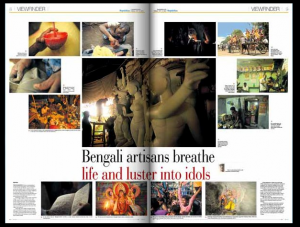The tradition of idol worshipping is as ancient as the garden-variety festivals celebrated by the Hindu community across the world. It is a cult that survives to this day and specially so on major religious occasions like Biswakarma Puja and Durga Puja, when devotees throng the idol sites to display an extravagant worship as a commemoration to their faith.Moulding dough of clay to give a perfect shape to which will soon become one of the many idols of deities around him in his temporary base in the Thapathali banks of Bagmati River in Kathmandu, artisan Dilip Murtikar instructs his assistants to start the paint job on the semi-finished clay statues.
Although Pal is Dilip’s original family name, he prefers to introduce himself as a Murtikar, which literally means a sculptor. The Pal community hails from West Bengal in India where the caste Pal would signify their artisan skills.Dilip migrated to Nepal two years ago, while exploring for a new market and he had never imagined, he’d be calling it home. And despite load shedding and break-even business, Dilip wants to see if he can make it here.“Clients (usually Marwari & Bengali community) want the idols at a cheap price but they don’t realize the meticulous hours it takes to make one,” he says, “A special kind of clay is required to make these idols and has to be brought from India.”The idol cult is also significant within the Pal community, their major deities being Manasa Devi, Santoshi Mata and Lord Vishnu. “Whenever someone from the community leaves the village for work, the idol of deity Kali is worshipped on their return.”
In the recent Viswakarma Puja, Dilip together with his wife, daughter and son-in-law and two assistants gave shape to some 127 idols. As Dashain nears, Dilip and his crew are busy making idols of Goddess Durga.
http://e.myrepublica.com/component/flippingbook/book/1035-republica-12-oct-2012/1-republica.html













